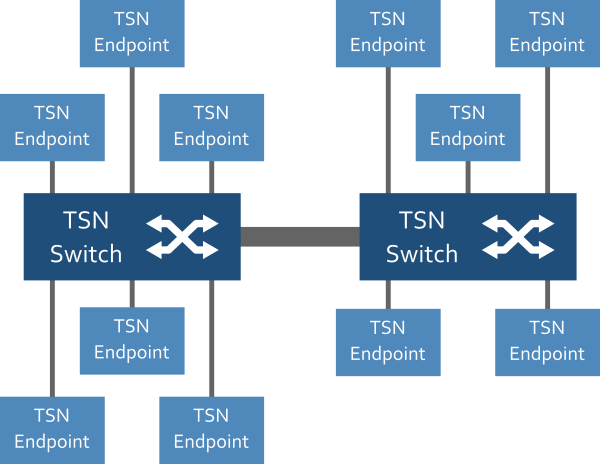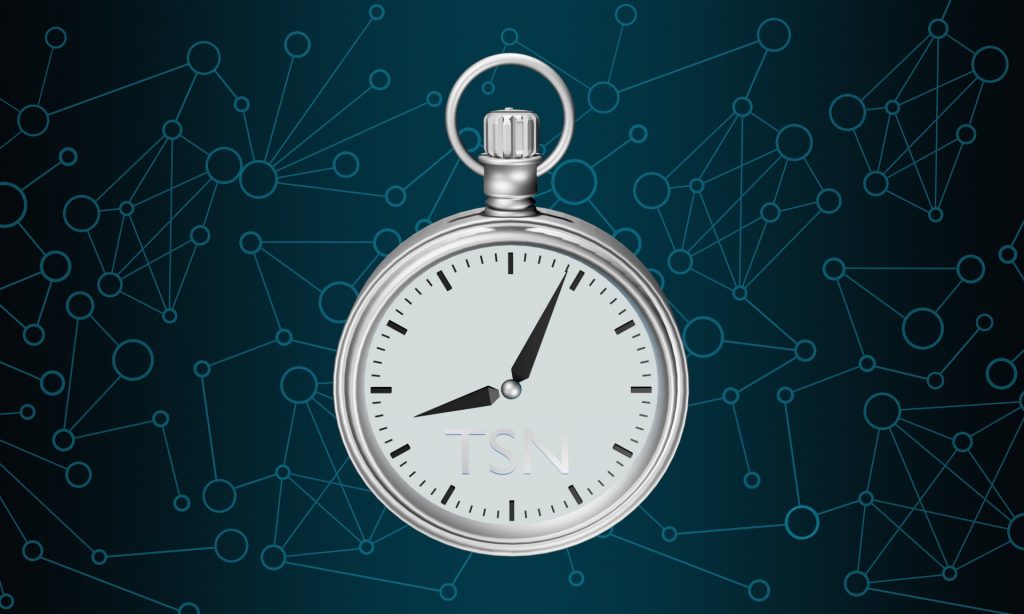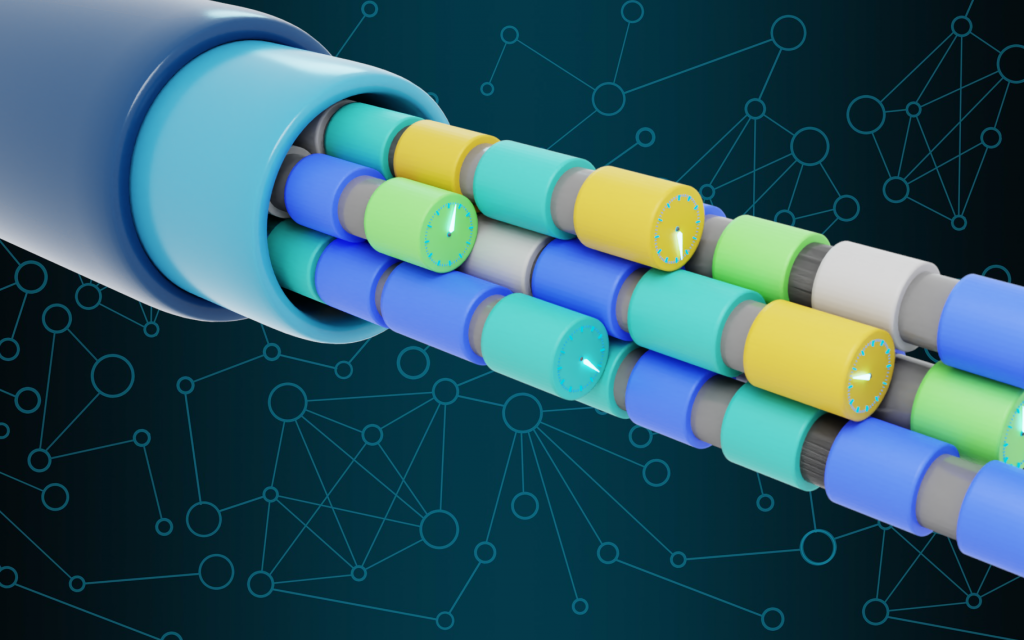
Time-Sensitive Networking (TSN)
A Real-Time Ethernet Solution Available in an Open IEEE 802.1 Standard
Time-Sensitive Networking (TSN) is an extension to the standard Ethernet protocol that enables real-time synchronization and deterministic, low-latency communication. TSN adds several critical features for applications requiring high availability, robustness, and reliability. These features include time-aware shapers, schedulers, and guard bands that allow for deterministic and bounded communication latency. TSN also supports redundancy and failover mechanisms to ensure high availability. Finally, TSN includes queuing disciplines and traffic scheduling algorithms that enable the prioritization of time-critical traffic.
Time-Sensitive Networking is typically implemented at Layer 2 of the OSI model, which means that it can be used with any type of network protocol. This makes Time-Sensitive Networking an ideal solution for time-sensitive applications requiring low latency and jitter.
A minimum set of functionalities to call it TSN is:
- Ethernet (transport medium)
- Time synchronization
- Traffic classification (priority handling)
Scheduled Traffic (Cycles and Time Slots)
Time-Sensitive Networking (TSN) is a technology that enables deterministic, low-latency communication over standard Ethernet networks. TSN allows devices to synchronize their clocks and send data at precise intervals, making it well-suited for time-critical applications such as industrial control and automation, automotive networking, and avionics. TSN is an extension of the IEEE 802.1 Ethernet standard and is currently being standardized by the IEEE 802.1 Time-Sensitive Networking Task Group. TSN utilizes several mechanisms to achieve its low-latency and deterministic performance, including scheduled traffic, policing, and buffering. By sending data at predetermined timeslots rather than as soon as it is available, TSN can minimize jitter and ensure that each packet arrives at its destination on time, providing guaranteed bandwidth. Policing can also be used to limit the amount of traffic that can be sent in each time slot, further reducing latency. Together, these features make TSN an appealing solution for time-critical applications that require deterministic behavior.
Devices in a System and What They Do
TSN Switch (aka Bridge)
-
TSN Ethernet Bridge Device
-
Manages time sync
-
Schedules traffic
-
Connects endpoints
Endpoint (aka End Station)
-
TSN Ethernet NIC card
-
Port that attaches to CPU host


Gateway
-
A device that connects different technologies and translates communication from one protocol to another
-
Example: TSN Ethernet to MIL-STD-1553 Gateway
IEEE 802 TSN Standards
The following is a quick overview of the IEEE TSN Standards

If you need more details, please support IEEE by downloading the full standard from the reference page

Time Synchronization
IEEE 802.1AS – Time synchronization
IEEE 802.1AS is a profile that enables synchronization compatibility between different TSN devices. Providing standard times and synchronization mechanisms allows for deterministic communication between devices. This is achieved through the Precision Time Protocol (PTP), which allows for phase and frequency synchronization over Ethernet. PTP is used to synchronize endpoints and switches to the Grand Master, with a jitter of ≤ 1μs. This ensures that all devices are accurately synchronized, allowing for deterministic communication.

Scheduling & Traffic Shaping
IEEE 802.1Q – Scheduling & Traffic Shaping
IEEE 802.1Q is the “all-encompassing” spec with several TSN specs incorporated and provides a mechanism for prioritizing traffic on a LAN. High-priority traffic is essential and has burdensome real-time requirements. Reserved traffic might have soft real-time requirements. Best-effort traffic is just best-effort traffic. IEEE 802.1Q uses a scheduler to determine when and how much bandwidth each type of traffic can use. The scheduler ensures that high-priority traffic gets the bandwidth it needs while giving reserved and best-effort traffic the best opportunity to use any leftover bandwidth. IEEE 802.1Q also uses a mechanism called “traffic shaping” to control the rate at which different types of traffic can be sent. Traffic shaping can help to protect against congestion and enable a better quality of service (QoS) for time-sensitive traffic.
IEEE 802.1Qbv – Time-Aware Shaper (TAS)
IEEE 802.1Qbv is a specification for time-aware shapers (TAS). A TAS divides the transmission into cycles, but each switch can have different TAS schedules. This way, message latency through a network is guaranteed. The time slot for each message is governed by the synchronized time of the devices. As IEEE 802.1Qbv removes the chance of real-time traffic impeding by best effort, it is beneficial for time-sensitive applications such as voice and video streaming.
IEEE 802.1cr – Asynchronous Traffic Shaping
IEEE 802.1cr Asynchronous Traffic Shaping (ATS) is a novel way of handling mixed traffic types that improves link utilization while still providing low latency for urgent traffic. With ATS, traffic is first classified into two categories: critical and non-urgent. Acute traffic is then given priority using a queuing and stream-reshaping technique known as the urgency-based scheduler (UBS). This approach helps ensure critical packets are never delayed while efficiently using available bandwidth. In addition, ATS can be easily implemented in existing network hardware, making it a powerful tool for improving network performance.
IEEE 802.1Qbu – Interspersing Express Traffic (IET) and Message Preempting
IEEE 802.3br – Specification and Management Parameters for Interspersing Express Traffic
IEEE 802.3br Interrupting & IEEE 802.1Qbu interspersing express traffic (IET), also known as frame preemption, is a mechanism that allows high-priority traffic to override lower-priority traffic on a network. When IET is enabled, low-priority traffic is pulsed while the high-priority message is transmitted. The low-priority message resumes without discarding the previously shared piece of the interrupted traffic. This allows for a smoother flow of traffic on a network and reduces the risk of dropped packets or lost data. IET is especially useful in situations where real-time applications are being used. IEEE 802.3br and IEEE 802.1Qbu are the two standards that define frame preemption and specify how it should be implemented on a network.
IEEE 802.1Qch – Deterministic Forwarding (CQF)
IEEE 802.1Qch is a standard for Ethernet that uses schedules to ensure packets are forwarded in a deterministic way, with minimal delay. This is accomplished by each hop storing the messages received in one cycle and forwarding them in the next. As a result, the maximum delay of each communication path is easily calculated. IEEE 802.1Qch also supports messages coming as bursts in the next cycle. This way, it can carry real-time traffic with very low latency and jitter. Consequently, IEEE 802.1Qch is an ideal solution for Ethernet applications that require deterministic and real-time performance.
IEEE 802.1Qav – Credit-Based Shaper
IEEE 802.1Qav is a traffic-shaping mechanism that reduces buffering in receiving bridges and endpoints. IEEE 802.1Qav uses credit-based shapers to avoid bursts of messages of the same traffic priority. IEEE 802.1Qav can change priorities between different traffic priorities during transmission. IEEE 802.1Qav uses the Stream Reservation Protocol to identify and reserve the lowest latency path for the information. IEEE 802.1Qav is an extension of IEEE 802.1Qau. Credit values are assigned to each piece of traffic that passes through the router or switch. These credit values can then adjust the traffic flow to prevent congestion and ensure optimal performance for all users. The credit mechanism is especially useful in situations where there is a wide variation in the type and speed of data being transmitted across the network, as it allows everything to be accommodated without compromising efficiency. Overall, the credit-based shaper effectively manages network traffic and ensures smooth performance for all users.
IEEE 802.1Qcc – Stream Definition, Scheduling & Bandwidth Configuration
IEEE 802.1Qcc stream definition provides specifications to support the configuration of deterministic streams in Time-Sensitive Networking (TSN) nodes. This includes time slots, bandwidth, maximum message sizes, and priorities that can be established for a communication stream. Qcc also supports both offline and online configuration of TSN network scheduling. IEEE 802.1Qcc is an extension to the IEEE 802.1Q bridging standard and is compatible with existing Ethernet technology. It builds on previous work in IEEE 802.1AS and IEEE 1588 to provide a comprehensive set of mechanisms for supporting time-sensitive applications over standard Ethernet networks.

Fault Tolerance and Security
IEEE 802.1Qci – Per-Stream Filtering & Policing (PSFP)
IEEE 802.1Qci is a quality of Service (QoS) standard that helps protect against faulty and malicious endpoints and switches. By isolating faults to specific regions in the network, IEEE 802.1Qci helps reduce the chances of widespread network outages. In addition, IEEE 802.1Qci provides features such as Per-Stream Filtering & Policing of incoming messages (PSFP), which helps protect the outgoing queues from flooding with messages. As a result, IEEE 802.1Qci can play an essential role in preventing network disruptions.
IEEE 802.1CB – Network Redundancy (FRER)
IEEE 802.1CB provides an Ethernet redundancy mechanism called FRER (First Receive Error Ratio). FRER monitors the number of packets received with errors on each incoming link. The link is considered faulty and disconnected if the number of errors exceeds a certain threshold. To avoid packet loss, FRER also duplicates messages sent on multiple paths. When a message is received, the receiver checks the redundancy tags to see if the message has already been received. If the message has not been received, it is accepted and forwarded. If the message has already been received, it is rejected and discarded. This ensures that only one copy of the message is delivered to the intended recipient.
IEEE 802.1Qca – Path Control And Reservation (PCR)
IEEE 802.1Qca path control and reservation (PCR) helps against faulty and malicious endpoints and switches by isolating faults to specific regions in the network. Qca PCR allows for the creation of logical topologies that separate different types of traffic and can be used to defend against Denial of Service (DoS) attacks. In addition, Qca PCR can help to improve network performance by reserving bandwidth for critical applications. As a result, IEEE 802.1Qca is an essential tool for ensuring the security and efficiency of modern networks.